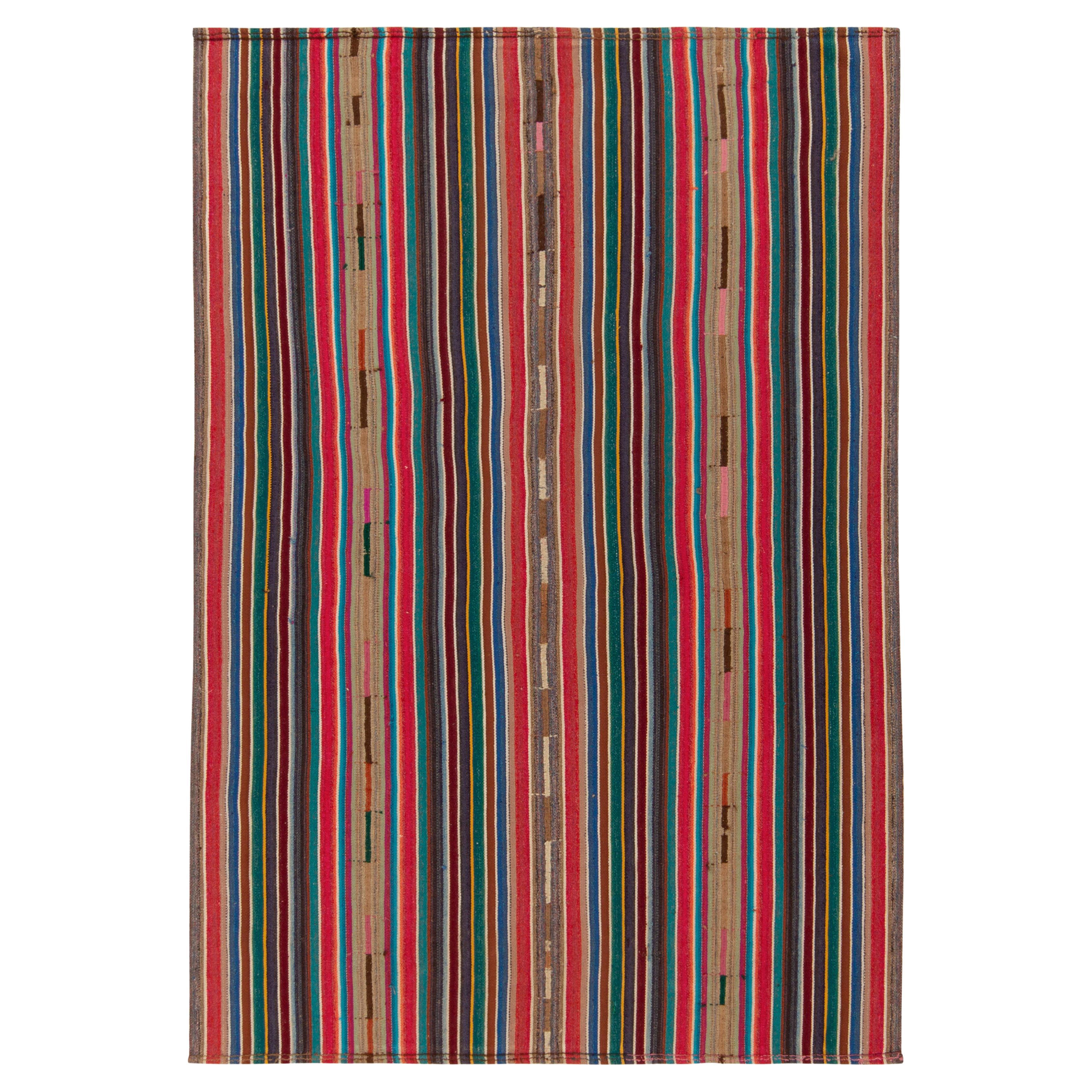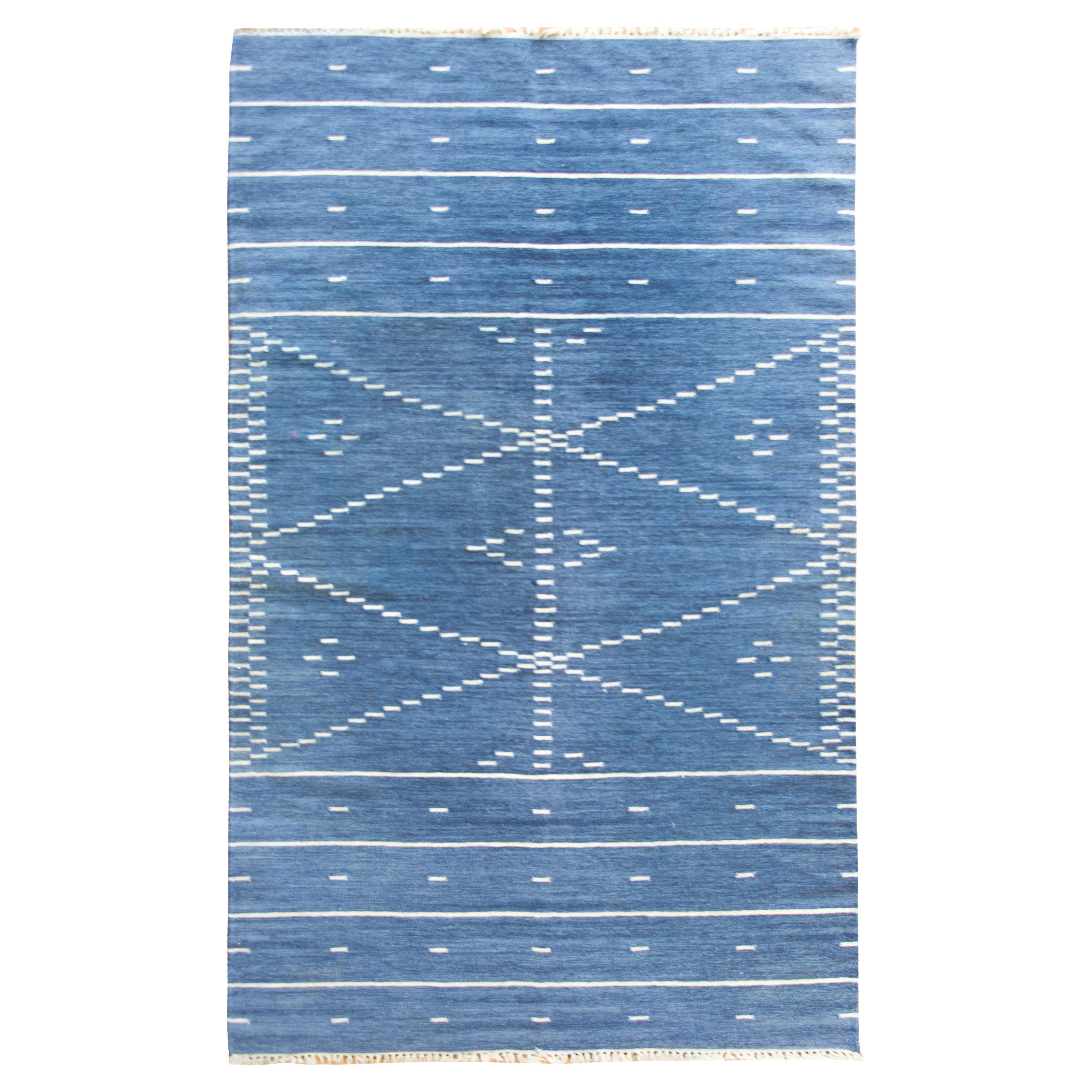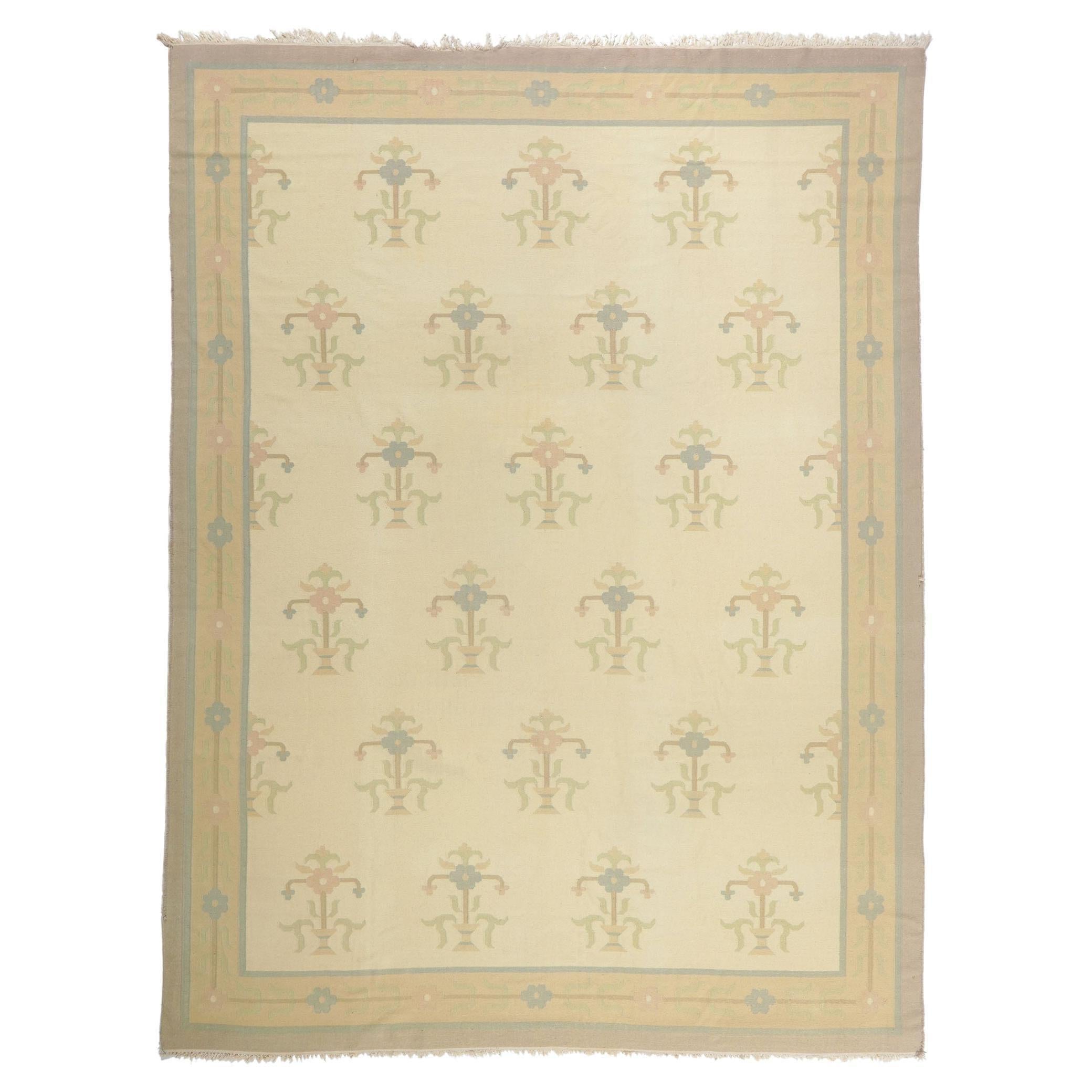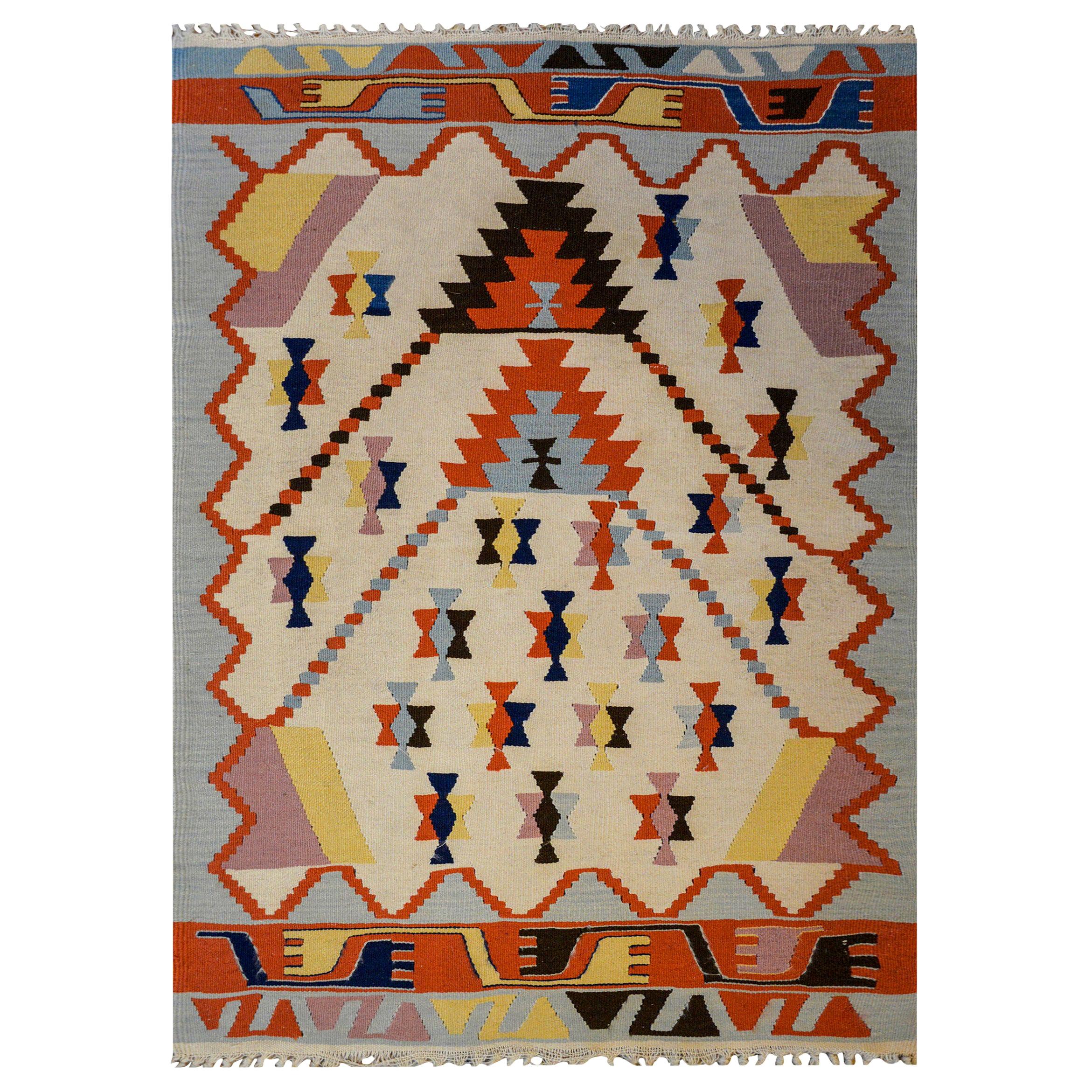Items Similar to 1950s Vintage Kilim Rug
Want more images or videos?
Request additional images or videos from the seller
1950s Vintage Kilim Rug
About the Item
Traditionally, the Indian rugs are some of the most desirable rugs amongst collectors and interior designers. India is known for their production of fine Indian textiles, palace size carpets, magnificent shawls and Art Deco rugs that were influenced by colonial British trends. Despite adverse conditions and invasions from overseas colonists and imperial powers, Indian craftspeople managed to maintain a diverse and individual textile culture. Even when the weavers of antique Indian rugs borrowed designs from Persia, they immediately attained a new flavor from the individuality of the Indian weavers.
- Dimensions:Width: 106 in (269.24 cm)Length: 141 in (358.14 cm)
- Style:Kilim (In the Style Of)
- Materials and Techniques:
- Place of Origin:
- Period:
- Date of Manufacture:1950
- Condition:Good Condition.
- Seller Location:Los Angeles, US
- Reference Number:
About the Seller
5.0
Gold Seller
These expertly vetted sellers are highly rated and consistently exceed customer expectations.
Established in 1920
1stDibs seller since 2023
30 sales on 1stDibs
Typical response time: <1 hour
- ShippingRetrieving quote...Ships From: Los Angeles, US
- Return PolicyA return for this item may be initiated within 3 days of delivery.
More From This SellerView All
- 1950s Vintage Floral Design Needlepoint RugLocated in Los Angeles, USAncient Roots Of Needlepoint Rugs Archaeologists and scholars consider the roots of needlepoint to have been around 1500 BC. They consider the first needlepoint to include the fine diagonal stitches that were used to sew tents together by the ancient Egyptians. The art eventually evolved into tapestry weaving. However, a tapestry weaving differs significantly from needlepoint in that it uses a loom and vertical warp. Tapestry weaving is closer to the weaving of kilims and pile rugs than canvas work. However, some still include tapestry weaving in the category of needlepoint because of the fine work that appeared during the late Renaissance. It can have a similar appearance to the untrained eye. Technically, tapestry weaving and needlepoint are not the same, and they do not use the same technique. The first actual needlepoint rugs and needle-points began to appear in the late Renaissance. Needlepoint is worked by creating stitches on a stiff canvas. The canvas is typically made from jute or linen and is quite durable. Pieces from the Renaissance were used to cover footstools, chairs, pillows, bed headboards, and other furnishings. They were also used as table coverings and wall coverings. You could also find them on many small items such as purses, shoes, and various adornments for clothing. During the Renaissance, the craft reached a high level of skill, and the designs became incredibly detailed and realistic. They mimicked many of the subjects and styles of famous paintings of the time. They created florals, still life designs, scenes, and geometric tiled pieces. Some of them mimicked the designs found in Persian Carpets. Needlepoint reached its peak popularity in the 19th century when it was considered a proper occupation for a lady. Needlepoint and embroidery held a similar place in societal status at the time. During this time, the work became finer, with some of the canvas reaching a high level of detail. The level of detail is determined by counting the number of mesh in an inch. During this time petit point by French needlewomen could have a mesh count as high as 45 mesh. This allowed women to create highly intricate designs with incredible levels of detail. Historical Needlepoint Carpets and Rugs It is possible to find many antique pieces of needlepoint besides rugs. Needlepoint rugs were popular in France and Spain, where the technique was adapted to create highly intricate designs that mimicked the designs in architecture and fashion. They were popular because they were durable, and it could be fashioned into a variety of items. The canvases themselves were durable, and the wool that they used was also strong, which means that many of the pieces were able to withstand daily use. We have many artifacts that have survived from this time period. Needlepoint rugs are important collectibles because they are different from the pile rugs and kilims that are typically found on the market. Needlepoint carpets are special because they take many hours to create, especially larger works. Needlepoint pieces of any type became popular throughout Europe during the 19th century. It is still a popular hobby today, but perhaps one of the most interesting stories is that of the Portuguese needlewomen of Arraiolos. The story of these women and their beautiful carpets begins in 1492. Needlepoint was a popular occupation in Spain, which had a large population of Moors and Jews. They were an integral part of Spanish culture. However, in 1492, Queen Isabella of Spain issued a proclamation that gave these ethnic groups the order to pack their bags and board ships headed...Category
Vintage 1950s Other Russian and Scandinavian Rugs
MaterialsWool
- Antique 1920 Indian RugLocated in Los Angeles, USTraditionally, the Indian rugs are some of the most desirable rugs amongst collectors and interior designers. India is known for their production of fine Indian textiles, palace size...Category
Vintage 1920s Indian Other Indian Rugs
MaterialsWool, Cotton
- Antique Indian Rug 7.1x5.8Located in Los Angeles, USAntique Indian Rug 7'1" X5'8" handmade and hand-knotted, wool on cotton foundation with floral design, authentic indian carpetCategory
Antique Early 1900s Other Indian Rugs
MaterialsWool, Cotton
- Antique 1920 Indian RugLocated in Los Angeles, USTraditionally, the Indian rugs are some of the most desirable rugs amongst collectors and interior designers. India is known for their production of fine Indian textiles, palace size...Category
Vintage 1920s Indian Other Indian Rugs
MaterialsWool, Cotton
- 1900s Antique Indian Amritsar RugLocated in Los Angeles, USDuring the period of Colonial rule over India, Amritsar rugs began to reflect Western influences in their design. The craftspeople of Northern India took their chance to profit from ...Category
Antique Early 1900s Indian Tribal Indian Rugs
MaterialsWool, Cotton
- Antique Botanical Indian Amritsar RugLocated in Los Angeles, USAntique Amritsar Rugs – The spectacular rugs of Amritsar capture the exotic style of India while incorporating a subtle colonial influence. This convergence of eastern and western styles results in an exceptionally alluring appearance that has been beloved by western consumers historically and today. The outstanding old Amritsar carpets were created by influential exporters to fuel the demand for exotic rugs...Category
Antique Early 1900s Indian Empire Indian Rugs
MaterialsWool, Cotton
You May Also Like
- 1950s Vintage Chaput Kilim Style in Multicolor Striped Pattern by Rug & KilimLocated in Long Island City, NYHailing from Turkey circa 1950-1960, a vintage chaput kilim rug from a rare new curation joining our flat weaves. Characterized by fine detailing with the...Category
Vintage 1950s Turkish Mid-Century Modern Indian Rugs
MaterialsWool
- 1950s Vintage Kilim Style in Blue, Polychromatic Stripe Patterns by Rug & KilimLocated in Long Island City, NYComing from Turkey circa 1950-1960, a bold type of chaput kilim rug style now entering our vintage flat weave curations. Boasting fine detailing with the colors within the polychroma...Category
Vintage 1950s Turkish Mid-Century Modern Indian Rugs
MaterialsWool
- Vintage Indian Kilim RugLocated in Chicago, ILA wonderful late 20th century Indian hand-woven kilim rug with an indigo ground covered in white diagonal stripes in the center with horizontal stripes at each end.Category
Late 20th Century Indian Kilim Indian Rugs
MaterialsWool
- Vintage Floral Dhurrie Kilim RugLocated in Dallas, TX78357 Vintage Floral Indian Dhurrie rug, 10'03 x 13'08. With its subdued ornamentation, incredible detail and texture, this handwoven wool vintage Indian floral Dhurrie...Category
Late 20th Century Indian Kilim Indian Rugs
MaterialsWool
- 1950s Vintage Tribal Rug in Red Open Field Brown Geometric Border by Rug & KilimLocated in Long Island City, NYHand-knotted in wool, a 4x12 rug from Rug & Kilim’s latest prominent curation of rare tribal pieces. Originating from Turkey circa 1950-1960, the piece enjoys a seldom-seen open ...Category
Vintage 1950s Turkish Tribal Indian Rugs
MaterialsWool
- Fun Vintage Indian Dhurrie Kilim RugLocated in Chicago, ILA fun vintage Indian Dhurrie Kilim rug with a bold geometric pattern woven in light and dark indigo, crimson gold, black and white wool surrounded by...Category
21st Century and Contemporary Indian Kilim Indian Rugs
MaterialsWool





